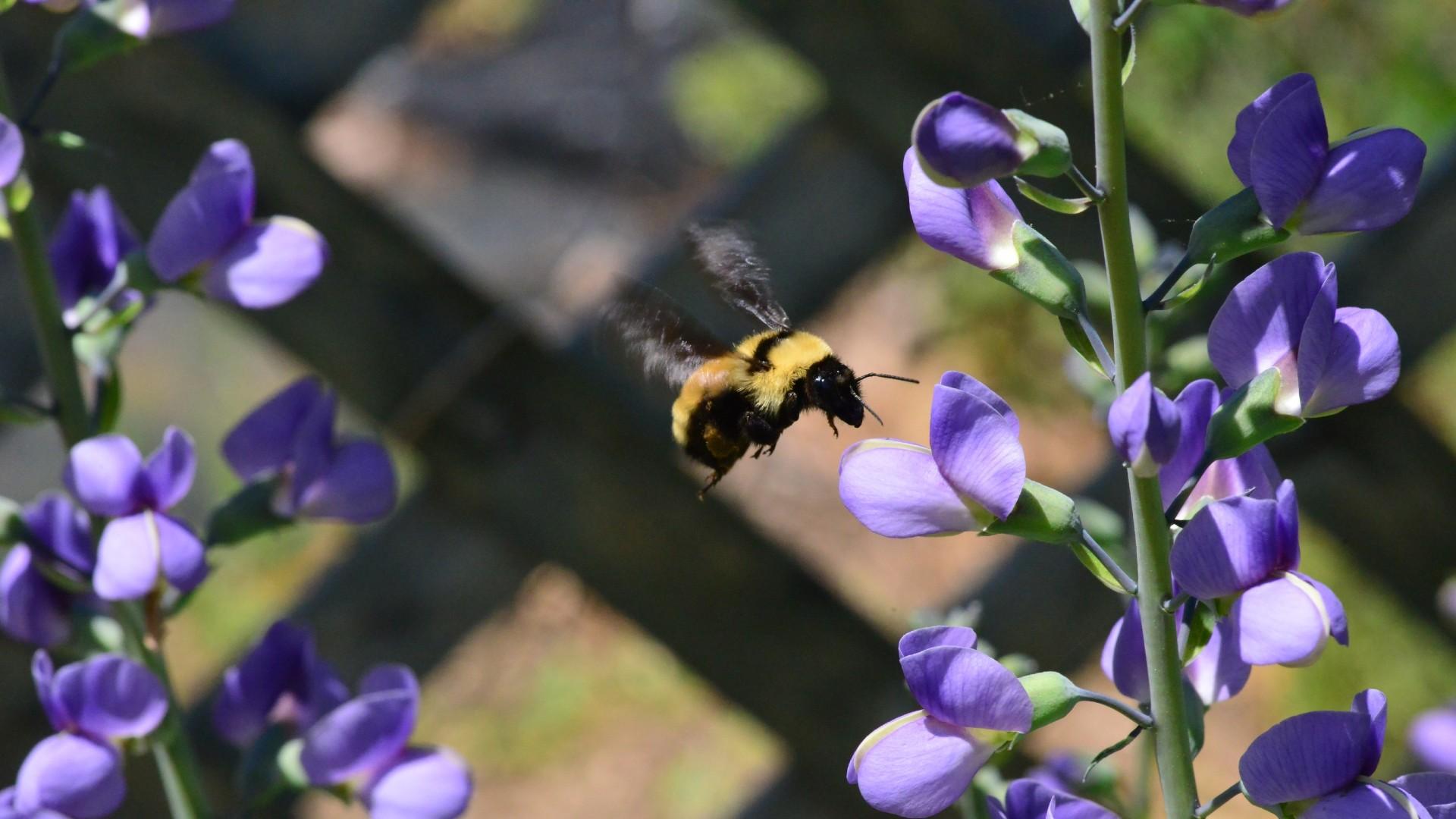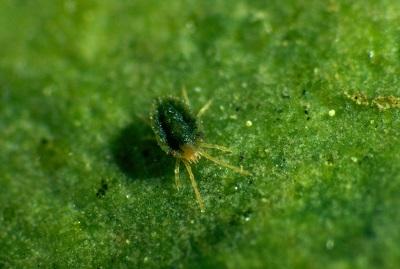
False blue indigo (Baptisia australis) begins to bloom in May.
Sustainable Gardening
- Try growing some of your own food this summer. Enjoy delicious produce, save money, and reduce climate-warming gas emissions associated with long-distance transportation and packaging of store-bought foods. Planting vegetables in containers is one way to get started.
- Learn how to manage pests without the use of pesticides. Use row covers over vegetable crops. Plant a variety of flowering plants to attract insects like ladybugs, lacewings, and flower flies -- they eat other insects and provide natural pest control.
- Avoid purchasing invasive plants such as Japanese barberry, privet, and Norway maple. They have negative impacts on wildlife and natural areas.
Trees & Shrubs
- If your azaleas, rhododendrons, and other spring-flowering shrubs are growing too large, prune them after they are finished blooming.
- Thin out interior boxwood branches to improve air circulation and reduce disease problems such as volutella canker. Also, look out for boxwood blight.
- Older leaves of holly and magnolia may begin to yellow and drop. This is a natural process of regeneration and does not indicate a problem with the trees.
Edible plants
- Begin setting out transplants of warm-season crops like squash, pepper, eggplant, and tomato. There is still a small possibility of late frosts. Be prepared to cover plants with a row cover, a tarp, paper bags, or a light blanket if frost is expected. Remove after the danger of frost has passed.
- Pinch the blooms from flower and vegetable transplants before you set them out. This will help direct the plants’ energies to root development and will result in more productive plants. Gently break up the roots of root-bound transplants before planting.
- Did your garden get overtaken by weeds last year? Start spreading mulch around plants and between rows. Use dried grass clippings (not treated with lawn herbicides), leaves collected from last fall, sections of newspaper covered with straw, or biodegradable landscape paper. Wood chips are excellent for paths between and around beds and rows.
- Cover strawberry plants with insect mesh, tulle (found in fabric stores), or a row cover before the berries become ripe to exclude birds, squirrels, and other hungry critters.
- Flea beetles are emerging as adults from their overwintering sites. Remove nearby weeds, rotate crop planting sites to reduce infestation, and place row covers over susceptible seedlings (e.g., eggplant, tomato) to exclude adults, and consider applying a repellent product like "Surround."
- Cucumber beetles are emerging from their overwintering sites. Place row covers over squash, melon, and cucumber seedlings and transplants until they bloom. Consider waiting to plant cucurbits (e.g., squash, cucumbers) until mid-June to avoid peak beetle populations.
Flowers
- Summer annual bulbs like gladiolus, tuberous begonias, cannas, caladium, and dahlias can be planted now.
- Attract pollinators and natural enemies to your landscape by planting a wide variety of flowering annuals and perennials, including native plants that will bloom over the entire growing season
Lawns
- Leave grass clippings where they lay. Grasscycling eliminates bagging labor and costs, adds organic matter and nitrogen to your soil, and does not contribute to thatch build-up.
Insects
Beneficial insects
- Lacewing larvae are emerging. The small alligator-like larvae are predators feeding on a wide range of garden pests. Ensure you know what the larvae, eggs, and pupae look like so you can leave them in your landscape and know they will be providing sustainable insect pest control. Reduce or eliminate pesticide use to support these beneficial insects. Ensure your landscape has a diversity of floral resources to support adult lacewing nutrition.
- Bumble bee queens are emerging from their overwintering sites and seeking nectar resources and a nesting location. Ensure your landscape has floral resources available to support bumble bee nutrition and their valuable pollination services. If you find a bumble bee nest, leave the nest alone, create a barrier around the nest, or contact a professional to relocate the nest if it is in an undesirable location. Help us learn more about bumble bees by submitting photos to the community science project Bumble Bee Watch.
- Mining bee adults are becoming active. This group of bees are important solitary pollinators that nest underground. When possible, leave the underground nests alone and consider adding educational signage indicating your conservation areas. Nesting can be deterred by increasing lawn density as these bees prefer sandy, well-drained areas with limited vegetation. Help us learn more about ground nesting bees by submitting photos to the community science project, Project GNBee.
- Carpenter bee adults are active. Carpenter bees are important pollinators, moving pollen between many of our vegetable plants and a variety of different flowers. Consider adding carpenter bee nesting sites by adding/leaving unwanted pieces of soft wood (e.g. cedar, redwood) or adding plants with hollow reeds or stems (e.g. stiff goldenrod [Solidago rigida], raspberry canes [Rubus spp.]). To deter carpenter bees from wooden human-made structures, avoid soft wood (cedar, redwood, and clear pines), paint and seal wood, and seal any holes or cracks.
Pests
- Boxwood psyllid nymphs (immatures) are emerging amongst boxwood leaves and producing a visible protective white waxy substance. Infested branches can be left alone, pruned out by mid-May, or sprayed with horticultural oil or insecticidal soap in early May.
- Lace bugs are emerging and may be seen on rhododendrons, azaleas, and herbaceous plants such as asters and goldenrods. Monitor for their piercing-sucking feeding damage (small light-colored stippling on the top side of leaves), and dark sticky frass and white shed "skins" (exoskeletons) on the underside of leaves. Low infestations can be managed with strong water sprays and/or left for predators and parasitoids. Heavy infestations can be managed with insecticidal soap or horticultural oil applications to the underside of leaves, where the insects are typically found.
- White prunicola scale crawlers (immatures) are emerging and commonly found on cherry laurel and other Prunus species. Monitor for crawler emergence by wrapping a piece of double-sided tape around scale-infested branches. When crawlers are seen stuck to the tape that is the ideal time to apply horticultural oil. Read and follow all chemical label instructions. Heavily-infested plants may need to be removed and replaced with less susceptible plant species.
- Spotted lanternfly (SLF) eggs will start hatching nymphs (immatures). Report any SLF egg hatch / early nymph sightings to the Maryland Department of Agriculture. If SLF eggs or nymphs are found in high numbers, the recommended control approach is to destroy the SLF physically. SLF is not harming landscape or garden plants enough to justify the risks of using pesticides that could harm beneficial insects.
- Ticks are active when the temperature is above freezing. Wear light-colored clothing and get in the habit of checking yourself, your loved ones, and your pets closely for ticks after spending time outdoors. Repellents are also an effective tool to keep ticks away.
- Four-lined plant bugs feed on a wide range of herbaceous plants in May-June, leaving small dark dots (stippling) on foliage. The spots eventually turn brown and may drop out, leaving holes. These insects are difficult to manage with insecticides, and there is only one generation per year. Most plants grow out of the damage by mid-summer.
- Cutworms will begin feeding on stems, foliage, and roots of fruit, vegetables, and turfgrass (wide host range). Place floating row covers over susceptible seedlings to exclude larvae, consider placing collars of newspaper, cardboard, or aluminum foil (3 inches tall and pushed into the soil) to prevent stem cutting, monitor for damage, maintain healthy dense lawns (or consider reducing your lawn), reduce pesticide use to encourage natural predators and parasitoids, and physically remove and destroy any larvae found.
- Jumping worms are hatching from their overwintering eggs in the soil. As the season progresses, monitor for these invasive worms and their granular coffee grounds-like castings. Prevent their spread by inspecting any plant materials you bring into your space and opting for bare-root plants from plant shares. If you have jumping worms, avoid sharing or moving plants or plant materials (compost, leaves, etc.). Hand-pick and destroy any identified jumping worms. There are currently no chemical control methods for invasive jumping worms. For identification help, send photos to Ask Extension.
Diseases
- Small reddish spots may appear on dogwood petals (bracts) or foliage due to a fungal infection by Elsinoë corni. Spotting can be an eyesore and may be more severe in years with wet spring weather, but is generally not a threat to long-term tree health.
- Rose Rosette, a disease of roses, is caused by a systemic virus that is spread by small eriophyid mites. It can kill landscape roses, including the more disease-resistant roses such as the Knockout cultivars. There is no cure for it.
Indoor plant and insect tips
Indoor plants
- Move houseplants outdoors after the danger of frost has passed. To avoid sunscald first place them in a shady location and over a period of two weeks or so gradually introduce them to more sunlight.
Pests

Photo: John Davidson, UMD (retired)
- Clover mites are usually most noticeable in the spring when temperatures are between 45° and 80°F and the humidity is high. On warm days they cross the grass and crawl up the sunny sides of buildings and will possibly enter into homes.They do not bite, carry diseases, or damage food or household furnishings except by leaving a red stain if crushed.
- Fleas are sometimes observed in homes where there are no pets. The most likely source is a wild animal such as a raccoon living in the attic, crawl space, chimney, or some other sheltered area connected to the inside of the home. If you have pets that have a flea problem, contact your veterinarian for the safest and most effective flea control products.